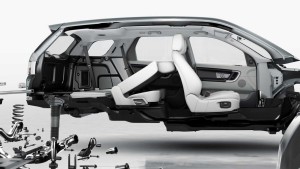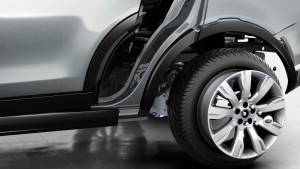 Land Rover recently tapped VFX/animation facility INK for a new spot that showcases the technological innovation packed inside its vehicles.
Land Rover recently tapped VFX/animation facility INK for a new spot that showcases the technological innovation packed inside its vehicles.
In the spot, the camera swoops around the Land Rover Discovery Sport, each shot pulling apart the chassis of the vehicle and revealing the mechanical renders hidden underneath.
“By combining technical understanding with beautiful imagery, we hoped to create an animation that remained visually engaging while clearly and accurately explaining the Discovery Sport’s packaging achievements,” explained David Macey, creative director at INK.
Pre-production kicked off following the initial pitch from Land Rover. “They knew they wanted to disassemble and pull apart the various parts of the vehicle, and show that when these various elements are put together again they result in something highly efficient. It was up to us to deliver on that vision,” said Macey. “We went away and starting putting together some ideas based on the concept. In parallel to that, the messaging, scripting and voiceover was being worked on by the agency FP Creative. There were those two parallel streams happening in tandem, and as the project progressed they grew closer and closer.”
 The next stage for INK was to create a blocking animatic in 3ds Max, which would define the duration and choreography of the animation. During this stage, the team also developed style frames to show Land Rover the look direction for the final product. “At that stage we also discussed how the project would be pipelined in terms of shot efficiency and getting everything done on time,” said Macey.
The next stage for INK was to create a blocking animatic in 3ds Max, which would define the duration and choreography of the animation. During this stage, the team also developed style frames to show Land Rover the look direction for the final product. “At that stage we also discussed how the project would be pipelined in terms of shot efficiency and getting everything done on time,” said Macey.
Having previously produced a series of animations exploring the Land Rover range, INK has built up a strong understanding of the product. This proved essential in meeting the visual demands of the brief. “At one end of the spectrum was the task of making sure that the practical design feats of everyday car components such as the glove box and USB ports were able to capture the attention they deserved,” explained Mike Haas, animation director at INK. “At the other, we faced the challenge of communicating very technical elements such as the Discovery Sport’s rear suspension system as cleanly and accessibly as possible.”
Choreographing the loose car parts, from the initial bursting apart through to the smooth and gradual reassembly – in such a way that the structure remained readable throughout the spot – required careful thought and planning.
“Maintaining the impact of the original explosion while ensuring that no shot became too visually chaotic was a fine balancing act,” said Haas. “It was a time-intensive task to work out how to choreograph all of the elements, and choose what should and shouldn’t be included, in such a way as to not confuse or overwhelm the viewer. We did a lot of work on the animatic before moving to rendering in V-Ray to make sure that we were really selling the shot in the best way possible.”
“The Discovery’s true uniqueness lies in the sum of its parts,” said Macey. “The things we’re highlighting in the film might be everyday objects, but there’s a backstory to them. People have spent two to three years designing each of them, maybe longer. Our job is to bring that story to life with animation, to take something that might normally be taken for granted, and to make it something really interesting.”





